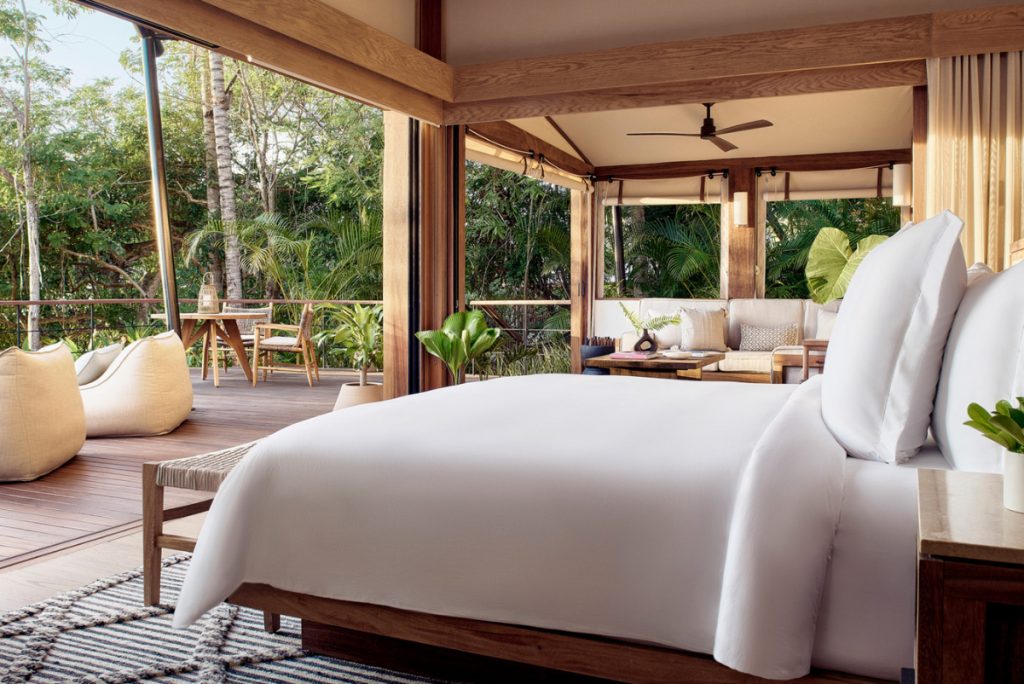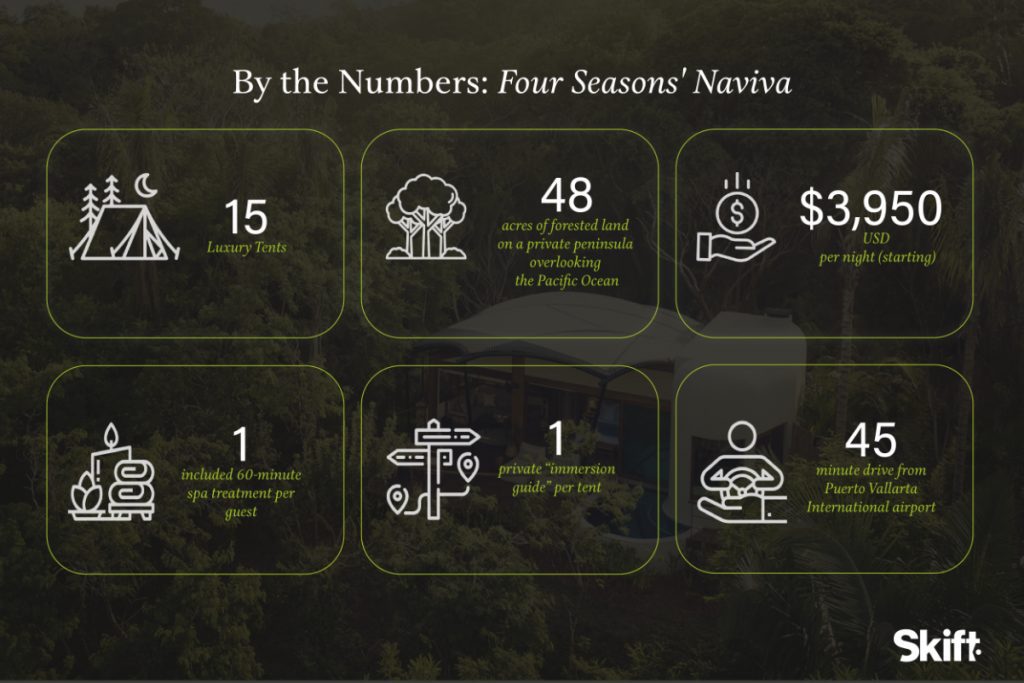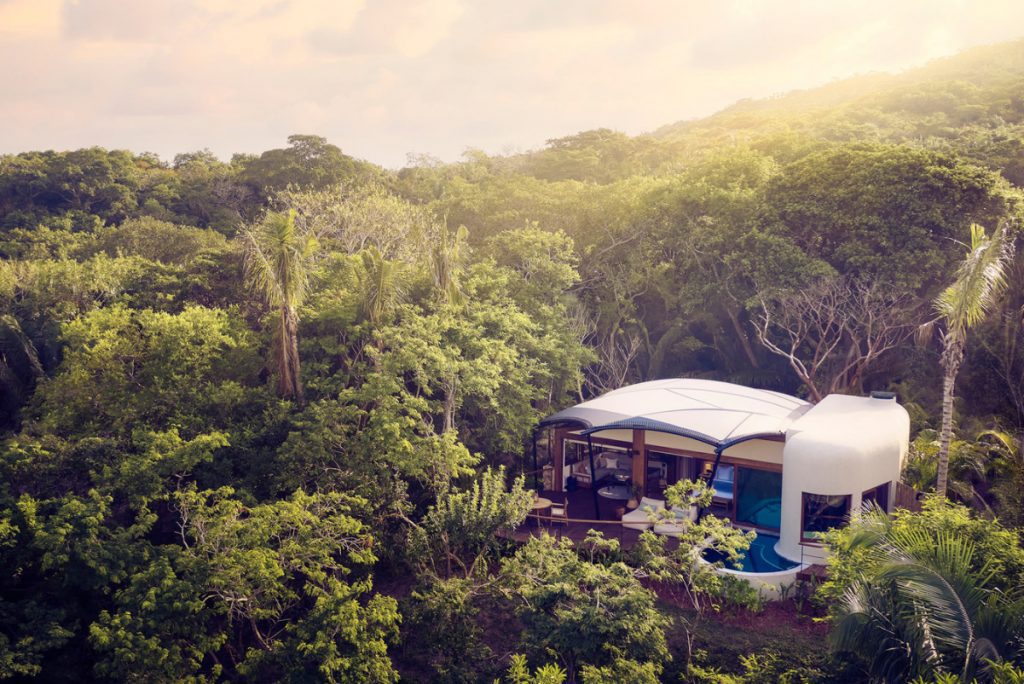Skift Take
True, the world already has its niche glamping products. But when the traditionalist Four Seasons also blurs the lines between indoors and out by adopting tented experiences, hotel designers worldwide will take notice.

Future of Hotel Design
What you need to know about the look, feel, and functionality of experiential innovation at cutting-edge properties. (See our past stories.)
Conventional hotel design doesn’t merely get left at the tent flap at Naviva, Four Seasons’ first luxury tented resort in the Americas. It gets tossed to the side with a metaphorical journey that begins by entering via a cocoon-inspired bamboo bridge spanning a deep forest ravine.
Opening officially on Thursday, December 1 in Punta Mita, Mexico, Naviva strives to immerse guests in 48 acres of lush greenery overlooking the Pacific Ocean from the canvas for a spiritual retreat – one that features just 15 accommodations celebrating canvas, wood, and water.
Luxury Frontiers was always the first choice of designers for Four Seasons Regional Vice president and Naviva General Manager John O’Sullivan.
“They have such a reverence for the culture and the people who live where they build,” O’Sullivan said. “Luxury Frontiers has a biophilic approach to design and such respect for the environment. Every aspect, from the materials used in construction to the beautifully appointed furnishings and accents all show such spirit.”
Preserving ecology and celebrating the culture of a destination is key, said Luxury Frontiers’ Head of Interior Architecture and Design Nadia Ghillino, who conducts in-depth site discovery workshops for every project she’s involved in. Notable successes include Nayara Tented Camp in Costa Rica and Puku Ridge in Zambia.
Ghillino’s philosophy comes to life at Naviva in tents with open-air living rooms. Separate bedrooms with local fabrics and natural textures that harmonize with what’s waiting just outside the floor-to-ceiling flaps where traditional windows would be.

Each of the 15 permanently installed tents has a plunge pool and an expansive deck with an outdoor shower. The only other people guests are likely to encounter are those delivering all-inclusive meals, or their private immersion guide to curate physical or spiritual activities.
This project included Ghillino’s first time architecting a temazcal “house of heat.” (When did your last luxury resort stay include visiting a sweat lodge?)
The tents are all private retreats, says O’Sullivan, but other areas are designed for more communal experiences – a notable departure from the aesthetic and culture of many luxury hotel brands.

O’Sullivan’s team describes their aspiration as a hybrid living room and kitchen of a private home. The goal is a space that serves as both a restaurant and gathering area for guests to enjoy music, conversation, or games like foosball on a table fashioned by Mexican artisans from reclaimed wood.
Some caveats are in order, though. Glamping is a risky product that can fall apart in practice. Any traveler who has done it during bad weather knows what can go awry. Upkeep costs may be higher for a brand, too, given the use of tent-like or wood structures prone to the elements.
Naviva also isn’t the first in this space. Amangiri, an Aman resort in Utah, has some tented pavilions called Camp Sarika, and Under Canvas has been creating in the U.S. other luxe tented experiences.
At Four Seasons’ Naviva, there are no TVs, working desks, or reception desks. Some guests may not like that but the company made this decision on purpose as part of a broader embrace of unplugged minimalism and escapism.
“There’s no one bringing you a bill, or anything to sign,” said O’Sullivan. “We’ve removed the transactional nature of hospitality. This is an unscripted approach to authentic connection with others, or even yourself.”
Naviva guests won’t see any food menu, either. Chefs create what guests request from what produce and proteins are available.
“Menus are rigid structures, which direct people to a code of conduct,” said O’Sullivan. “We prefer to have a level of spontaneous experiences, where you are the architect, instead of us being the deliverer of what those are.”
All in all, Naviva is one signpost pointing toward the future of hotel design. A closing thought:
“Interior architecture is a discipline with one foot outside and one foot inside. The success of the interior design is reliant on its seamless integration, continuous spatial flow, and conceptual progression with the architectural design. No interior exists in isolation from the architecture that holds it.”
—Nadia Ghillino, Luxury Frontiers’ head of interior architecture and design
Daily Lodging Report
Essential industry news for hospitality and lodging executives in North America and Asia-Pacific. Delivered daily to your inbox.
Tags: design, four seasons, future of hotel design, future of lodging, glamping, hotel design, luxury, mexico, outdoors
Photo credit: Images of Four Seasons' new Naviva brand of luxurious tented experiences. Four Seasons
